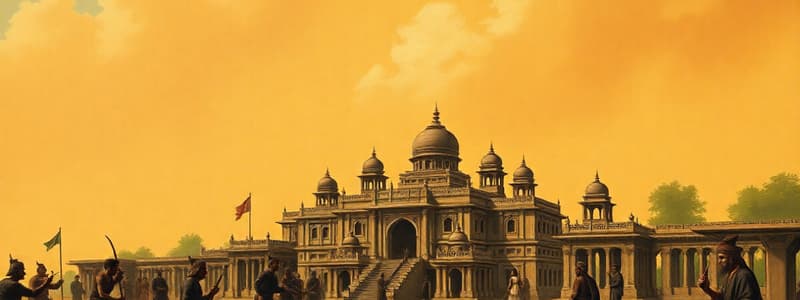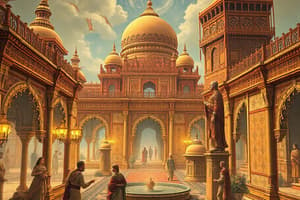Podcast
Questions and Answers
What were the three major powers in Deccan and Northern India around 750 AD?
What were the three major powers in Deccan and Northern India around 750 AD?
Gurjara-Pratihara, Pala, and Rashtrakutas.
What marks the end of Harsha’s rule and the beginning of political fragmentation?
What marks the end of Harsha’s rule and the beginning of political fragmentation?
The year 647 AD marks the end of Harsha's rule.
What was the significance of the Tripartite Struggle?
What was the significance of the Tripartite Struggle?
The Tripartite Struggle was a conflict between the Gurjara-Pratihara, Pala, and Rashtrakutas for dominance over Northern India.Importance of Kannauj.
Which dynasty ruled from 550 AD to 985 AD in Southern India?
Which dynasty ruled from 550 AD to 985 AD in Southern India?
Identify a major event that occurred in 543 AD relevant to the political context of India.
Identify a major event that occurred in 543 AD relevant to the political context of India.
What characterized the period after Harsha's rule in terms of political structure?
What characterized the period after Harsha's rule in terms of political structure?
Which two dynasties are mentioned alongside the Chalukyas of Vengi?
Which two dynasties are mentioned alongside the Chalukyas of Vengi?
What impact did the Tripartite Struggle have on medieval India?
What impact did the Tripartite Struggle have on medieval India?
Which region's history is primarily associated with the Chalukyas?
Which region's history is primarily associated with the Chalukyas?
What was a defining feature of the political landscape of Northern India around 750 AD?
What was a defining feature of the political landscape of Northern India around 750 AD?
What significant political change occurred after the decline of Harsha's empire?
What significant political change occurred after the decline of Harsha's empire?
In what century did Harsha's rule end?
In what century did Harsha's rule end?
Which region became notable for its instability following Harsha's decline?
Which region became notable for its instability following Harsha's decline?
What was the consequence of the absence of a central power in India after Harsha?
What was the consequence of the absence of a central power in India after Harsha?
Name one of the regions that were affected by the decline of Harsha's empire.
Name one of the regions that were affected by the decline of Harsha's empire.
What type of warfare characterized the period after Harsha's empire?
What type of warfare characterized the period after Harsha's empire?
Explain the term 'power vacuum' in the context of Harsha's decline.
Explain the term 'power vacuum' in the context of Harsha's decline.
How did the political landscape change in India during the 7th century after Harsha's rule?
How did the political landscape change in India during the 7th century after Harsha's rule?
What was a major characteristic of the states that emerged after Harsha's rule?
What was a major characteristic of the states that emerged after Harsha's rule?
Identify one factor that contributed to the fragmentation of India after Harsha's decline.
Identify one factor that contributed to the fragmentation of India after Harsha's decline.
Flashcards
What happened in India after Harsha's rule?
What happened in India after Harsha's rule?
India experienced a period of fragmentation and instability, with numerous small kingdoms vying for power after the decline of Harsha's empire.
What was the significance of Kannauj after Harsha's death?
What was the significance of Kannauj after Harsha's death?
The region around Kannauj became a focal point of power struggles, as different factions competed for control.
How did the decline of Harsha's empire impact India's political structure?
How did the decline of Harsha's empire impact India's political structure?
After the decline of Harsha's empire, the unified power structure of India weakened, resulting in a decentralized political landscape.
What were the consequences of the absence of a central power in India?
What were the consequences of the absence of a central power in India?
Signup and view all the flashcards
What was the primary characteristic of the political landscape after Harsha's rule?
What was the primary characteristic of the political landscape after Harsha's rule?
Signup and view all the flashcards
How did India's political landscape transform after Harsha's decline?
How did India's political landscape transform after Harsha's decline?
Signup and view all the flashcards
What was the main consequence of the constant conflict between kingdoms?
What was the main consequence of the constant conflict between kingdoms?
Signup and view all the flashcards
How did the post-Harsha period mark a transition in Indian history?
How did the post-Harsha period mark a transition in Indian history?
Signup and view all the flashcards
What was the overall impact of the post-Harsha period on India?
What was the overall impact of the post-Harsha period on India?
Signup and view all the flashcards
What are some of the key characteristics of the post-Harsha period in India?
What are some of the key characteristics of the post-Harsha period in India?
Signup and view all the flashcards
Period of Political Fragmentation (647 AD - 750 AD)
Period of Political Fragmentation (647 AD - 750 AD)
Signup and view all the flashcards
3 Major Powers: Gurjara-Pratihara, Pala & Rashtrakutas
3 Major Powers: Gurjara-Pratihara, Pala & Rashtrakutas
Signup and view all the flashcards
Kannauj
Kannauj
Signup and view all the flashcards
Gurjara-Pratihara
Gurjara-Pratihara
Signup and view all the flashcards
Pala Dynasty
Pala Dynasty
Signup and view all the flashcards
Rashtrakuta Dynasty
Rashtrakuta Dynasty
Signup and view all the flashcards
Tripartite Struggle
Tripartite Struggle
Signup and view all the flashcards
Tripartite Struggle: Lasting Impact
Tripartite Struggle: Lasting Impact
Signup and view all the flashcards
Shift in Political Landscape
Shift in Political Landscape
Signup and view all the flashcards
Turning Point in History
Turning Point in History
Signup and view all the flashcards
Study Notes
India After Harsha's Rule
- Harsha's reign ended in 647 AD
- After Harsha's death, a power vacuum emerged in the region around Kannauj.
- The absence of a central power led to a period of political fragmentation.
- Numerous smaller states emerged, constantly fighting for control and changing their borders.
- The period after Harsha's rule witnessed the rise of several major powers.
- Key kingdoms included the Gurjara-Pratiharas, Palas, and Rashtrakutas.
- These powers often engaged in a tripartite struggle for dominance in the region around Kannauj.
- The period following Harsha's empire is known as a period of political fragmentation.
Studying That Suits You
Use AI to generate personalized quizzes and flashcards to suit your learning preferences.




